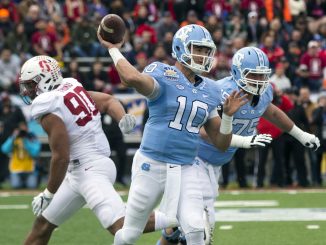
The Cleveland Cavaliers have a lot of problems. Primarily, they trail the Golden State Warriors 2-0 in the NBA Finals. They lost those first two games by a combined 48 points, and if you peel the layers of the onion back just a bit, you’ll find a list of problematic trends: their defense can’t contain Golden State’s speed and shooting range, Kyrie Irving and Kevin Love — currently in the concussion protocol following a blow to the back of the head in Game 2 — have struggled, and their bench is getting absolutely crushed. Even with LeBron James, they’re at a serious disadvantage in terms of talent.
We could go on and list additional reasons why the Cavs have gotten blown out to start the Finals, but lets be positive and look for a possible route for them to reverse course.
The only road map for the Cavaliers to pick up a win at home — as the series shifts to Cleveland for Games 3 and 4 — involves them taking and making more 3-pointers. The ball needs to be in LeBron’s hands with the court spread, and Cleveland’s roster of snipers (they have a plethora of good shooters) have to start knocking down triples for them to even have a chance of making this a contest.
During the first three rounds of this year’s playoffs, the Cavaliers steamrolled through their Eastern Conference foes, losing just two games, behind a barrage of 3-pointers. In those first 14 games, they averaged 33.2 three-point attempts, making 14.4 of them — good for a robust 43.4 percent. Cleveland currently has six players on their roster who are attempting at least one 3-pointer per game and shooting 43 percent on better. Throughout the postseason, the Cavs have especially sizzled from the corners: 74-160 (46.3 percent) on 3-pointers from those two shot locations. Here’s their shot chart, courtesy of NBA.com:
But in the first two games of the Finals, Cleveland has gone just 3-11 on those valuable corner treys. In total, they’ve attempted 44 3-pointers in the Finals, and made just
J.R. Smith, who was one of just eight players to make 200+ 3-pointers during the regular season, continued his long-range marksmanship in the playoffs: he’s shot a ridiculous 49 percent on catch-and-shoots threes (you’ll notice Love right behind Smith on that list, too). In the Finals, though, Smith has attempted nine total field goals (in 539 minutes), and he’s just 2-7 on 3-pointers. During last year’s championship series, Smith disappeared, and so far through two games, the same thing is happening in 2016. LeBron’s the best in the world at using dribble penetration to setup shooters for open looks around the perimeter, but if his top outlet is MIA, then that throws a serious wrench into Cleveland’s offense.Smith isn’t along in this regard. Irving (1-7), Love (3-9) and Channing Frye (0-1) have all failed to get going from distance, too.
Even against Golden State’s army of rangy perimeter defenders, LeBron has gotten to the rim. 12 of his 16 made field goals have come from within five feet of the basket. The Warriors are backing off James, not respecting his bricky jumper. When he does drive, usually against Andre Igudoala, their help defenders are staying home on shooters, which means LeBron doesn’t have anyone to kick to.
The best way to generate an open jump shot involves swinging the ball from side-to-side, and forcing defensive rotations. This is where the Warriors complicate everything for opponents. The Dubs can switch every screen — on and off the ball, especially when they go small with Draymond Green at center. It’s not just that Golden State has a lot of long-armed defender. Their roster is filled with intelligent athletes, who move together on a string defensively. When they’re dialed in, finding a crack or crevice in their defense is damn near impossible. It’s much easier to defend the three-point line when you don’t have to worry about rotations.
If the Cavs are going to generate better perimeter looks, they have to both play and move the ball faster. It’s far too stagnant right now, and it’s on LeBron and Irving to speed things up. Cleveland can also do things like slipping screens and backdoor cuts to counter Golden State’s switches. But if they don’t heat up from deep, this thing is over. Perhaps it already is.



